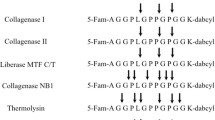Abstract
Transglutaminases (TGs) comprise a protein family in which the members catalyze the formation of isopeptide bonds between glutamine and lysine residues in various proteins. Expression studies on its three major members, FXIII, TG1, and TG2, have been performed in a relatively large number of mammalian tissues in comparison with those on the other isozymes. We previously identified a highly reactive substrate peptide, including glutamine, for each isozyme from a phage display library and developed a method for detecting isozyme-specific activities by incorporating a labeled substrate peptide into lysine residues of proteins. Here, we describe genetically encoded Förster resonance energy transfer (FRET)-based probes composed of each fluorescence protein (Cerulean and EVenus) fused with substrate peptides. The probe pairs, designated as Trac-MTG (His-CerΔ11-LQ/EV-K-His) containing linker and substrate peptide sequence for microbial TG (MTG), increased the EVenus:Cerulean fluorescence intensity ratio by more than 1.5-fold. Furthermore, we demonstrated that Trac-TG1 (His-CerΔ11-K5) and Trac-TG2 (His-CerΔ11-T26) containing substrate peptide sequence for mammalian TGs successfully detected the isozyme-specific activity of TG1 and TG2, respectively. In this study, we developed a rapid and convenient experimental system for measuring the isozyme-specific activity of TGs. The application of these probes for analyses in cells and tissues will be helpful for elucidating the physiological and pathological functions of TGs.




Similar content being viewed by others
Abbreviations
- CBB:
-
Coomassie brilliant blue
- FXIIIA:
-
Coagulation factor FXIII A chain
- PBS:
-
Phosphate-buffered saline
- TG:
-
Transglutaminase
References
Abe H, Goto M, Kamiya N (2011) Protein lipidation catalyzed by microbial transglutaminase. Chemistry 17:14004–14008. doi:10.1002/chem.201102121
Brummel KE, Paradis SG, Butenas S et al (2002) Thrombin functions during tissue factor-induced blood coagulation. Blood 100:148–152. doi:10.1182/blood.v100.1.148
Caron NS, Munsie LN, Keillor JW, Truant R (2012) Using FLIM-FRET to measure conformational changes of transglutaminase type 2 in live cells. PLoS One. doi:10.1371/journal.pone.0044159
Eckert RL, Kaartinen MT, Nurminskaya M et al (2014) Transglutaminase regulation of cell function. Physiol Rev 94:383–417. doi:10.1152/physrev.00019.2013
Hitomi K, Kitamura M, Sugimura Y (2009) Preferred substrate sequences for transglutaminase 2: screening using a phage-displayed peptide library. Amino Acids 36:619–624. doi:10.1007/s00726-008-0126-6
Hitomi K, Kojima S, Fésüs L (eds) (2015) Transglutaminases, multiple functional modifiers and targets for new drug discovery, 1st edn. Springer, Tokyo
Horikawa K, Yamada Y, Matsuda T et al (2010) Spontaneous network activity visualized by ultrasensitive Ca2+ indicators, yellow Cameleon-Nano. Nat Methods 7:729–732. doi:10.1038/nmeth.1488
Iismaa SE, Mearns BM, Lorand L, Graham RM (2009) Transglutaminases and disease: lessons from genetically engineered mouse models and inherited disorders. Physiol Rev 89:991–1023. doi:10.1152/physrev.00044.2008
Kamiya N, Tanaka T, Suzuki T et al (2003) S-peptide as a potent peptidyl linker for protein cross-linking by microbial transglutaminase from Streptomyces mobaraensis. Bioconjug Chem 14:351–357. doi:10.1021/bc025610y
Kanaji T, Ozaki H, Takao T et al (1993) Primary structure of microbial transglutaminase from Streptoverticillium sp. strain s-8112. J Biol Chem 268:11565–11572
Lorand L, Graham RM (2003) Transglutaminases: crosslinking enzymes with pleiotropic functions. Nat Rev Mol Cell Biol 4:140–156. doi:10.1038/nrm1014
Muszbek L, Bereczky Z, Bagoly Z et al (2011) Factor XIII: a coagulation factor with multiple plasmatic and cellular functions. Physiol Rev 91:931–972. doi:10.1152/physrev.00016.2010
Nakanishi Y, Iida S, Ueoka-Nakanishi H et al (2013) Exploring dynamics of molybdate in living animal cells by a genetically encoded FRET nanosensor. PLoS One. doi:10.1371/journal.pone.0058175
Pavlyukov MS, Antipova NV, Balashova MV, Shakhparonov MI (2012) Detection of transglutaminase 2 conformational changes in living cell. Biochem Biophys Res Commun 421:773–779. doi:10.1016/j.bbrc.2012.04.082
Sugimura Y, Hosono M, Wada F et al (2006) Screening for the preferred substrate sequence of transglutaminase using a phage-displayed peptide library: identification of peptide substrates for TGASE 2 and Factor XIIIA. J Biol Chem 281:17699–17706. doi:10.1074/jbc.M513538200
Sugimura Y, Hosono M, Kitamura M et al (2008) Identification of preferred substrate sequences for transglutaminase 1–development of a novel peptide that can efficiently detect cross-linking enzyme activity in the skin. FEBS J 275:5667–5677. doi:10.1111/j.1742-4658.2008.06692.x
Tanaka Y, Tsuruda Y, Nishi M et al (2007) Exploring enzymatic catalysis at a solid surface: a case study with transglutaminase-mediated protein immobilization. Org Biomol Chem 5:1764–1770. doi:10.1039/b701595j
Acknowledgments
This work was supported by a Grant-in-Aid for Scientific Research (B) (No. 26292192 to K.H.) and also Grant-in-Aid for Young Scientists Research No. (No. 26860500 and 16K09353 to H.T.) from the Ministry of Education, Sports, Science and Technology (JSPS, KAKENHI, Japan). The authors would like to thank Enago for the English language review.
Author information
Authors and Affiliations
Corresponding author
Ethics declarations
Conflict of interest
The authors declare that they have no conflict of interests. This article does not contain any studies with human participants or animals performed by any of the authors.
Additional information
Handling Editors: S. Beninati, M. Piacentini, C.M. Bergamini.
Rights and permissions
About this article
Cite this article
Tatsukawa, H., Liu, H.H., Oba, S. et al. FRET-based detection of isozyme-specific activities of transglutaminases. Amino Acids 49, 615–623 (2017). https://doi.org/10.1007/s00726-016-2322-0
Received:
Accepted:
Published:
Issue Date:
DOI: https://doi.org/10.1007/s00726-016-2322-0




